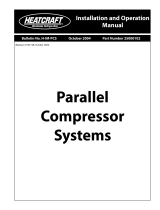
12 SS-APG008-EN
Remodel, Retrofit, or Replacement
Inevitably, older condensing unit/evaporator systems that are designed for use with a refrigerant
other than R-410A will need to be upgraded. Due to the phase-out of many of these older
refrigerants, the major components for those older condensing unit/evaporator systems may no
longer be available. The only option will be to convert the system to R-410A, POE oil, and R-410A
components.
When upgrading an existing refrigerant split system due to remodel, retrofit, or replacement, the
entire system must be reviewed for compatibility with R-410A and POE oil. Each and every part of
the split HVAC system MUST be compatible with the properties of R-410A refrigerant and POE oil.
In addition, ensure the existing electrical service and protection are correct for the product being
installed.
WARNING
R-410A Refrigerant under Higher Pressure than R-22!
The units described in this manual use R-410A refrigerant, which operates at higher pressures
than R-22 refrigerant. Use ONLY R-410A rated service equipment or components with this unit.
For specific handling concerns with R-410A, please contact your local Trane representative.
Failure to use R-410A rated service equipment or components could result in equipment or
components exploding under R-410A high pressures which could result in death, serious injury,
or equipment damage.
Every part of an existing split system needs to be analyzed to determine if it can be reused in an
R-410A and POE oil system:
• R-22 condensing units will not work with R-410A.
• Most older evaporator coils were not pressure and cycle rated for R-410A pressures. If they
weren’t, they will need to be replaced. Check with the manufacturer.
• Suction lines 2-5/8 OD and smaller of type L copper are suitable for use with R-410A. Suction
lines 3-1/8 OD must use type K or thicker wall.
• Discharge lines, liquid lines, heat pump vapor lines, and hot gas bypass lines 1-3/8 OD and
smaller of type L copper are suitable for use with R-410A. These same lines sized at 1-5/8 OD
or 2-1/8 OD must use type K or thicker wall.
• R-410A refrigerant line sizes may be different than the existing line sizes. The lines need to be
re-sized and compared to existing lines for reusability.
• Expansion valves need to be reselected. Expansion valves are refrigerant specific.
• Any gasket or o-ring should be replaced. Shrinkage of the original seal may occur after an HFC
conversion, potentially causing a refrigerant leak. Components commonly affected are
Schraeder cores, solenoid valves, ball valves, and flange seals. But all external seals in contact
with refrigerant should be viewed as potential leak sources after a retrofit.
• All other valves, filters, valve packing, pressure controls, and refrigeration accessories must be
researched through their manufacturer for compatibility with the pressures of an R-410A
system, and for their compatibility with the newer POE oil.
• For the best performance and operation, the original mineral oil should be removed from the
components of the system that are not being replaced. Any component of the system that is
suspected of trapping oil (piping, traps, and coil), should be dismantled, drained, and
reassembled. After all components have been drained, the amount of residual mineral oil will
have a negligible effect on performance and reliability.
Note: POE oil is hygroscopic—it absorbs water directly from the air. This water is nearly
impossible to remove from the compressor oil and can cause compressor failures. For this
reason, the system should not be open for longer than necessary, dry nitrogen should flow
in the system while brazing, and only new containers of oil should be used for service and
maintenance.
All Codes take precedence over anything written here.























